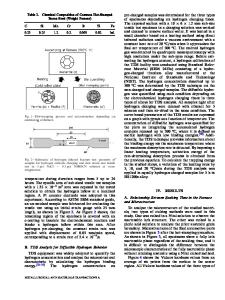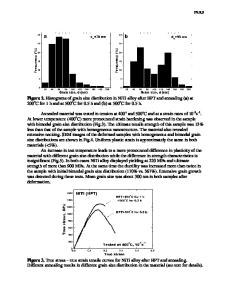Nonuniform distribution of carbonitride particles and its effect on prior austenite grain size in the simulated coarse-g
- PDF / 702,620 Bytes
- 8 Pages / 612 x 792 pts (letter) Page_size
- 38 Downloads / 357 Views
I.
INTRODUCTION
THE interaction between a grain boundary and secondphase particles has been a topic of great interest since Zener proposed a simple model for that interaction.[1] In his model, he balanced the driving force for motion action of a rigid grain boundary with the counterforce exerted by spherical particles on the boundary. For the equilibrium, the following relationship was obtained: d } (ra /f )
[1]
where d is the average grain size, ra is the average particle radius, and f is the volume fraction of the second-phase particles. Equation [1] assumes a random distribution of particles. The basic relation between d, ra, and f is still valid, though several modifications for the formula have been presented, by considering the effect of the ratio of boundary curvature radius to particle radius and the relation between curvature and grain size distribution and/or particle size distribution.[2,3,4] It has been observed by several authors[5,6] that the addition of an excess amount of Ti causes the prior austenite grains to grow in the coarse-grained heat-affected zone (HAZ) of welded high-strength low-alloyed (HSLA) steels. ‘‘Excess Ti’’ here means that the added amount of Ti is more than the optimum content, which is usually of the stoichiometric ratio of Ti/N 5 3.42. Qian et al.[5] reported that 0.022 pct Ti gave rise to growth of the prior austenite grains in a quenched and tempered HSLA steel with Ti/N 5 4.4, and Seppa¨la¨[6] showed that 0.031 pct Ti resulted in D.W. TIAN, Research Fellow, and L.P. KARJALAINEN, Professor, are with the Department of Mechanical Engineering, University of Oulu, FIN-90571 Oulu, Finland. BAINIAN QIAN and XIAOFENG CHEN, Professors, are with the Institute of Metal Research, Academia Sinica, 110015 Shenyang, People’s Republic of China. Manuscript submitted August 21, 1995. METALLURGICAL AND MATERIALS TRANSACTIONS A
a distinctly coarsened grain size in a thermomechanical control-processed (TMCP) steel with Ti/N 5 6.5. This coarsening tendency was attributed to the coarsening of the precipitate particles because of hyperstoichiometric Ti. High levels of added titanium would cause precipitation of big TiN particles in the liquid if virtually all the nitrogen were fixed as TiN.[7] The increase in the Ti content, however, gives rise to an increment not only in particle size but also in the particle volume fraction for a given content of nitrogen. Therefore, the coarsening tendency of grain size cannot be simply determined using Eq. [1] without quantitative data, in which d, ra, and f must be related to each other. Two types of nonuniform distribution of carbonitride particles have been noted by some authors.[8–11] In the first type, the particles tend to be located at the prior austenite grain boundaries,[8,9] making the pinning more effective. Consequently, a correction factor for Eq. [1] was expressed as follows:[8] feff 5 4 fobs
[2]
where feff and fobs are the effective and observed volume fractions of the particles, respectively. In the other type, the particles appear in clu
Data Loading...











